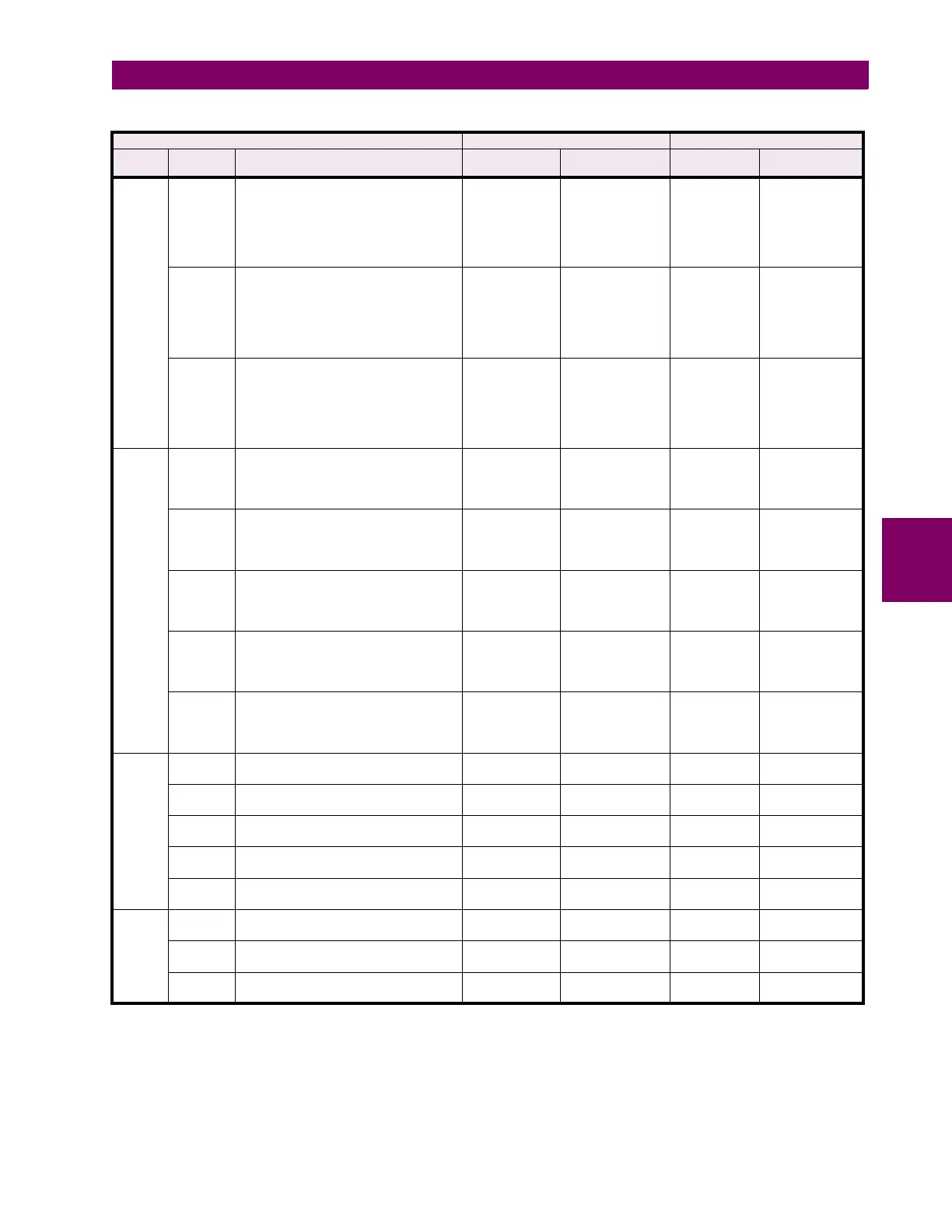GE Multilin C30 Controller System E-5
APPENDIX E E.1 DEVICE PROFILE DOCUMENT
E
20
cont’d
2 16-Bit Binary Counter 1 (read)
7 (freeze)
8 (freeze noack)
9 (freeze clear)
10 (frz. cl. noack)
22 (assign class)
00, 01 (start-stop)
06 (no range, or all)
07, 08 (limited quantity)
17, 28 (index)
129 (response) 00, 01 (start-stop)
17, 28 (index)
(see Note 2)
5 32-Bit Binary Counter without Flag 1
(read)
7 (freeze)
8 (freeze noack)
9 (freeze clear)
10 (frz. cl. noack)
22 (assign class)
00, 01 (start-stop)
06 (no range, or all)
07, 08 (limited quantity)
17, 28 (index)
129 (response) 00, 01 (start-stop)
17, 28 (index)
(see Note 2)
6 16-Bit Binary Counter without Flag 1 (read)
7 (freeze)
8 (freeze noack)
9 (freeze clear)
10 (frz. cl. noack)
22 (assign class)
00, 01 (start-stop)
06 (no range, or all)
07, 08 (limited quantity)
17, 28 (index)
129 (response) 00, 01 (start-stop)
17, 28 (index)
(see Note 2)
21 0 Frozen Counter
(Variation 0 is used to request default
variation)
1 (read)
22 (assign class)
00, 01 (start-stop)
06 (no range, or all)
07, 08 (limited quantity)
17, 28 (index)
1 32-Bit Frozen Counter 1 (read)
22 (assign class)
00, 01 (start-stop)
06 (no range, or all)
07, 08 (limited quantity)
17, 28 (index)
129 (response) 00, 01 (start-stop)
17, 28 (index)
(see Note 2)
2 16-Bit Frozen Counter 1 (read)
22 (assign class)
00, 01 (start-stop)
06 (no range, or all)
07, 08 (limited quantity)
17, 28 (index)
129 (response) 00, 01 (start-stop)
17, 28 (index)
(see Note 2)
9 32-Bit Frozen Counter without Flag 1 (read)
22 (assign class)
00, 01 (start-stop)
06 (no range, or all)
07, 08 (limited quantity)
17, 28 (index)
129 (response) 00, 01 (start-stop)
17, 28 (index)
(see Note 2)
10 16-Bit Frozen Counter without Flag 1 (read)
22 (assign class)
00, 01 (start-stop)
06 (no range, or all)
07, 08 (limited quantity)
17, 28 (index)
129 (response) 00, 01 (start-stop)
17, 28 (index)
(see Note 2)
22 0 Counter Change Event (Variation 0 is used
to request default variation)
1 (read) 06 (no range, or all)
07, 08 (limited quantity)
1 32-Bit Counter Change Event 1 (read) 06 (no range, or all)
07, 08 (limited quantity)
129 (response)
130 (unsol. resp.)
17, 28 (index)
2 16-Bit Counter Change Event 1 (read) 06 (no range, or all)
07, 08 (limited quantity)
129 (response)
130 (unsol. resp.)
17, 28 (index)
5 32-Bit Counter Change Event with Time 1 (read) 06 (no range, or all)
07, 08 (limited quantity)
129 (response)
130 (unsol. resp.)
17, 28 (index)
6 16-Bit Counter Change Event with Time 1 (read) 06 (no range, or all)
07, 08 (limited quantity)
129 (response)
130 (unsol. resp.)
17, 28 (index)
23 0 Frozen Counter Event (Variation 0 is used
to request default variation)
1 (read) 06 (no range, or all)
07, 08 (limited quantity)
1 32-Bit Frozen Counter Event 1 (read) 06 (no range, or all)
07, 08 (limited quantity)
129 (response)
130 (unsol. resp.)
17, 28 (index)
2 16-Bit Frozen Counter Event 1 (read) 06 (no range, or all)
07, 08 (limited quantity)
129 (response)
130 (unsol. resp.)
17, 28 (index)
Table E–2: IMPLEMENTATION TABLE (Sheet 2 of 4)
OBJECT REQUEST RESPONSE
OBJECT
NO.
VARIATION
NO.
DESCRIPTION FUNCTION
CODES (DEC)
QUALIFIER
CODES (HEX)
FUNCTION
CODES (DEC)
QUALIFIER
CODES (HEX)
Note 1: A default variation refers to the variation responded when variation 0 is requested and/or in class 0, 1, 2, or 3 scans. The default varia-
tions for object types 1, 2, 20, 21, 22, 23, 30, and 32 are selected via relay settings. Refer to the Communications section in Chapter 5
for details. This optimizes the class 0 poll data size.
Note 2: For static (non-change-event) objects, qualifiers 17 or 28 are only responded when a request is sent with qualifiers 17 or 28, respec-
tively. Otherwise, static object requests sent with qualifiers 00, 01, 06, 07, or 08, will be responded with qualifiers 00 or 01 (for change-
event objects, qualifiers 17 or 28 are always responded.)
Note 3: Cold restarts are implemented the same as warm restarts – the C30 is not restarted, but the DNP process is restarted.
